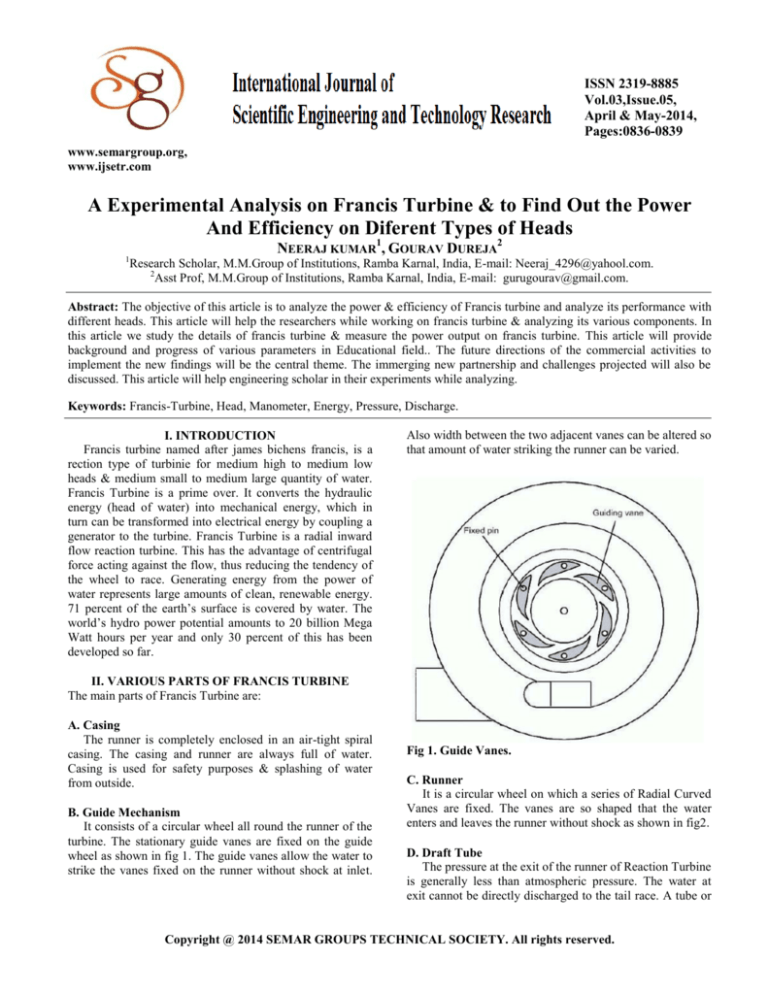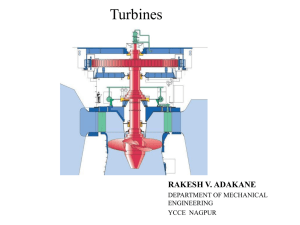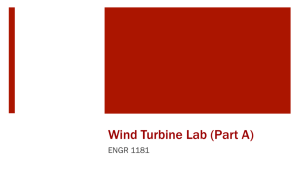
ISSN 2319-8885
Vol.03,Issue.05,
April & May-2014,
Pages:0836-0839
www.semargroup.org,
www.ijsetr.com
A Experimental Analysis on Francis Turbine & to Find Out the Power
And Efficiency on Diferent Types of Heads
NEERAJ KUMAR1, GOURAV DUREJA2
1
Research Scholar, M.M.Group of Institutions, Ramba Karnal, India, E-mail: Neeraj_4296@yahool.com.
2
Asst Prof, M.M.Group of Institutions, Ramba Karnal, India, E-mail: gurugourav@gmail.com.
Abstract: The objective of this article is to analyze the power & efficiency of Francis turbine and analyze its performance with
different heads. This article will help the researchers while working on francis turbine & analyzing its various components. In
this article we study the details of francis turbine & measure the power output on francis turbine. This article will provide
background and progress of various parameters in Educational field.. The future directions of the commercial activities to
implement the new findings will be the central theme. The immerging new partnership and challenges projected will also be
discussed. This article will help engineering scholar in their experiments while analyzing.
Keywords: Francis-Turbine, Head, Manometer, Energy, Pressure, Discharge.
I. INTRODUCTION
Francis turbine named after james bichens francis, is a
rection type of turbinie for medium high to medium low
heads & medium small to medium large quantity of water.
Francis Turbine is a prime over. It converts the hydraulic
energy (head of water) into mechanical energy, which in
turn can be transformed into electrical energy by coupling a
generator to the turbine. Francis Turbine is a radial inward
flow reaction turbine. This has the advantage of centrifugal
force acting against the flow, thus reducing the tendency of
the wheel to race. Generating energy from the power of
water represents large amounts of clean, renewable energy.
71 percent of the earth’s surface is covered by water. The
world’s hydro power potential amounts to 20 billion Mega
Watt hours per year and only 30 percent of this has been
developed so far.
Also width between the two adjacent vanes can be altered so
that amount of water striking the runner can be varied.
II. VARIOUS PARTS OF FRANCIS TURBINE
The main parts of Francis Turbine are:
A. Casing
The runner is completely enclosed in an air-tight spiral
casing. The casing and runner are always full of water.
Casing is used for safety purposes & splashing of water
from outside.
B. Guide Mechanism
It consists of a circular wheel all round the runner of the
turbine. The stationary guide vanes are fixed on the guide
wheel as shown in fig 1. The guide vanes allow the water to
strike the vanes fixed on the runner without shock at inlet.
Fig 1. Guide Vanes.
C. Runner
It is a circular wheel on which a series of Radial Curved
Vanes are fixed. The vanes are so shaped that the water
enters and leaves the runner without shock as shown in fig2.
D. Draft Tube
The pressure at the exit of the runner of Reaction Turbine
is generally less than atmospheric pressure. The water at
exit cannot be directly discharged to the tail race. A tube or
Copyright @ 2014 SEMAR GROUPS TECHNICAL SOCIETY. All rights reserved.
NEERAJ KUMAR, GOURAV DUREJA
pipe of gradually increasing area is used for discharging
water from the exit of turbine to the tail race. This tube of
increasing area is called Draft Tube. One end of the tube is
connected to the outlet of runner while the other end is submerged below the level of water in the tail-race.
The main types of reaction turbines are
Radially outward flow reaction turbine: This reaction
turbine consist a cylindrical disc mounted on a shaft and
provided with vanes around the perimeter. At inlet the water
flows into the wheel at the centre and then glides through
radially provided fixed guide vanes and then flows over the
moving vanes. The function of the guide vanes is to direct
or guide the water into the moving vanes in the correct
direction and also regulate the amount of water striking the
vanes. The water as it flows along the moving vanes will
exert a thrust and hence a torque on the wheel thereby
rotating the wheel. The water leaves the moving vanes at the
outer edge. The wheel is enclosed by a water-tight casing.
The water is then taken to draft tube.
Radially inward flow reaction turbine: The constitutional
details of this turbine are similar to the outward flow turbine
but for the fact that the guide vanes surround the moving
vanes. This is preferred to the outward flow turbine as this
turbine does not develop racing. The centrifugal force on the
inward moving body of water decreases the relative velocity
and thus the speed of the turbine can be controlled easily.
Fig 2. Runner.
Runner with vanes: The runner is mounted on a shaft and
the blades are fixed on the runner at equal distances. The
vanes are so shaped that the water reacting with the m will
pass through them thereby passing their pressure energy to
make it rotate the runner.
IV. DIAGRAM OF FRANCIS TURBINE
A. Francis turbine
Fig 3. Components of Francis Turbine.
III. WORKING OF FRANCIS TURBINE
A. Reaction Turbines
Reaction turbines are those turbines which operate under
hydraulic pressure energy and part of kinetic energy. In this
case, the water reacts with the vanes as it moves through the
vanes and transfers its pressure energy to the vanes so that
the vanes move in turn rotating the runner on which they are
mounted.
Fig 4. Francis turbine.
International Journal of Scientific Engineering and Technology Research
Volume.03, IssueNo.05, April & May-2014, Pages: 0836-0839
A Experimental Analysis on Francis Turbine & to Find Out the Power And Efficiency on Diferent Types of Heads
The principal feature of a francis turbine that
distinguishes it from an impulse turbine is that only a part of
the total head available at the inlet to the turbine is
converted to velocity head, before the runner is reached.
Also in the reaction turbines the working fluid, instead of
engaging only one or two blades, completely fills the
passages in the runner. The pressure or static head of the
fluid changes gradually as it passes through the runner along
with the change in its kinetic energy based on absolute
velocity due to the impulse action between the fluid and the
runner. Therefore the cross-sectional area of flow through
the passages of the fluid. A reaction turbine is usually well
suited for low heads. A radial flow hydraulic turbine of
reaction type was first developed by an American Engineer,
James B. Francis (1815-92) and is named after him as the
Francis turbine. The schematic diagram of a Francis turbine
is shown in Fig 3 and 4.
B. A Francis turbine comprises mainly the four
components
spiral casing,
Guide on stay vanes,
Draft-tube as shown in Fig 4,
Runner blades.
Spiral Casing: Most of these machines have vertical shafts
although some smaller machines of this type have horizontal
shaft. The fluid enters from the penstock (pipeline leading to
the turbine from the reservoir at high altitude) to a spiral
casing which completely surrounds the runner. This casing
is known as scroll casing or volute. The cross-sectional area
of this casing decreases uniformly along the circumference
to keep the fluid velocity constant in magnitude along its
path towards the guide vane. This is so because the rate of
flow along the fluid path in the volute decreases due to
continuous entry of the fluid to the runner through the
openings of the guide vanes or stay vanes.
Fig 5. Spiral Casing.
Guide or Stay Vane: The basic purpose of the guide vanes
or stay vanes is to convert a part of pressure energy of the
fluid at its entrance to the kinetic energy and then to direct
the fluid on to the runner blades at the angle appropriate to
the design. Moreover, the guide vanes are pivoted and can
be turned by a suitable governing mechanism to regulate the
flow while the load changes. The guide vanes are also
known as wicket gates. The guide vanes impart a tangential
velocity and hence an angular momentum to the water
before its entry to the runner. The flow in the runner of a
Francis turbine is not purely radial but a combination of
radial and tangential. The flow is inward, i.e. from the
periphery towards the centre. The height of the runner
depends upon the specific speed. The height increases with
the increase in the specific speed. The main direction of
flow change as water passes through the runner and is
finally turned into the axial direction while entering the draft
tube.
Draft Tube: The draft tube is a conduit which connects the
runner exit to the tail race where the water is being finally
discharged from the turbine. The primary function of the
draft tube is to reduce the velocity of the discharged water to
minimize the loss of kinetic energy at the outlet. This
permits the turbine to be set above the tail water without any
appreciable drop of available head. A clear understanding of
the function of the draft tube in any reaction turbine, in fact,
is very important for the purpose of its design. The purpose
of providing a draft tube will be better understood if we
carefully study the net available head across a reaction
turbine.
V. OBSERVATIONS / CALCULATION / RESULT*
Data:-
g =9.81m/s2
P m =1360kg/m3
D =0.08m
dR= 0.012m
W3=1.2 Kg
International Journal of Scientific Engineering and Technology Research
Volume.03, IssueNo.05, April & May-2014, Pages: 0836-0839
NEERAJ KUMAR, GOURAV DUREJA
Pw =1000 kg/m3
Cv =0.98
dB =0.2m
W4 =0. Kg
[3] A Text Book of Fluid Mechanics and Hydraulic
Machines. Front Cover. R. K. Bansal. Firewall Media, Jan
1, 2005 - Fluid mechanics.
Calculations:
H= 10(Pd + Ps/ 760), m of water =…15.26 m of water
A= π/4 D2, m2 =…5.02x10-3. m2
V = CV X√ 2GH X (ρm/ ρw -1), m/sec =2.67m/sec
T= (W 1+W3-W2) X g X Re , Nm =0.955 Nm
Eo = 2x π x N x T/60x1000, KW = 0.332 KW
Q= Vx A, m3/Sec=0.013 m3/Sec
h=h1- h2/100 m =0.03m
Ei = ρw x gx Q x H/100, KW = 9.60KW
Re = dB + 2dR/2, m =0.112 m
ηt = Eo/ Ei x 100 % = 34 %
Nomenclature:
A= Cross – Sectional area of pipe, m2
Cv= Coefficient of pilot tu
D= Diameter of Pipe , m
db= Diameter of brake drum , m
dR= Diameter of rope ,m
Ei=Input power kW
Eo= Output Power, kW
g=Acceleration due to gravity, m/s2
H=Total head, m
h=Differential Pressure of manometer, m
h1, h2=Manometric reading at both pints, CM
N=RPM of runner shaft
Pd=Devilry Pressure, kg/cm2
Ps=Suction pressure, mmHg
Q=Discharge m3 /sec
Re = Equivalent Radius, m
T=Torgue / Nm
V=Velocity of water, m/s
W1= Applied weight, Kg
W2=Dead weight (obtain from spring balance ),Kg
W3=Weinght of hanger, Kg
W4= Weight of rope , Kg
pw=Density of water ,kg/ m3
pm=Density of Manometer fluid i.e.Hg, kg/ m3
nt=Turbine efficiency
[4] Hydraulics and Hydraulic Machines ,. M.N. Shesha
Prakash, Professor, J.N.N. College of Engineering,
Shimoga.
[5] Modeling of fluid flow inside UMP’S francis turbine
using ,computational fluid dynamics (CFD) , Muhammad
nur bin hashim , Faculty of Mechanical Engineering
University malaysia pahang , Thesis , ( November ,2009).
[6] Mr. Sudip Adhikari is a graduate of Mechanical
Engineering from Kathmandu University (KU), and is
working at the Turbine Testing Lab as a Research Assistant.
Author’s Profile:
Neeraj Kumar received the B.Tech in
Mechanical Engineering from N.C.C.E
(ISRANA) panipat, haryana During 2008
& M.Tech in thermal Engineering From
NIT KKR INDIA DURING 2012.he join
the MMGI ramba karnal India college as
a assistant professor in mechanical
department.
Gourav Dureja received the B.Tech in Civil Engineering
from M.M.University Mullana Haryana
During 2013 he join the MMGI ramba
karnal India college as a Lecturer in Civil
Department.
VI. REFERENCES
[1] Collaboration for Establishing Francis Turbine
Manufacturing and Testing Facility in Nepal, Supriya
Koirala*, Sudip Adhikari, Biraj S. Thapa, Bhola Thapa, and
Ole G. Dahlhaug, Rentech Symposium Compendium,
Volume 1, March 2012.
[2] Voith Hydro Holding GmbH & Co. KG
,Alexanderstrasse 11 ,89522 Heidenheim/Germany ,Tel.
+49 7321 37 0 Fax +49 7321 37 7828 ,info. Voithhydro
@voith.com ,www.voithhydro.com, A Voith and Siemens
Company.
International Journal of Scientific Engineering and Technology Research
Volume.03, IssueNo.05, April & May-2014, Pages: 0836-0839








